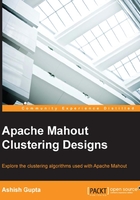
Conventions
In this book, you will find a number of text styles that distinguish between different kinds of information. Here are some examples of these styles and an explanation of their meaning.
Code words in text, database table names, folder names, filenames, file extensions, pathnames, dummy URLs, user input, and Twitter handles are shown as follows: "Once done, you can test it by typing the command – mahout and this will show you the same screen as shown in preceding figure."
A block of code is set as follows:
generateSamples(500, 1, 1, 3); // 500 samples of sd 3 generateSamples(300, 1, 0, 0.5); //300 sample of sd 0.5 generateSamples(300, 0, 2, 0.1); //300 sample of sd 0.1
Any command-line input or output is written as follows:
bin/mahoutcanopy --input /user/hue/20newsdatavec/tfidf-vectors/ --output /user/hue/canopycentroids --distanceMeasure org.apache.mahout.common.distance.EuclideanDistanceMeasure –t1 1550 --t2 2050--method mapreduce
New terms and important words are shown in bold. Words that you see on the screen, for example, in menus or dialog boxes, appear in the text like this: "Click on the Keys and Access Tokens tab, and you will find ConsumerKey and ConsumerSecret under Application Settings."